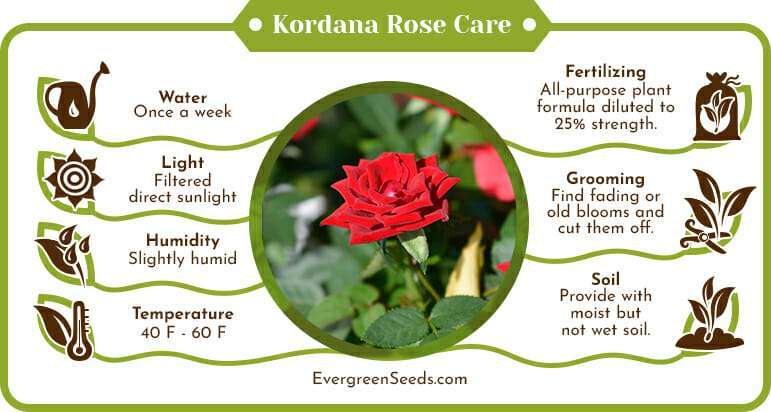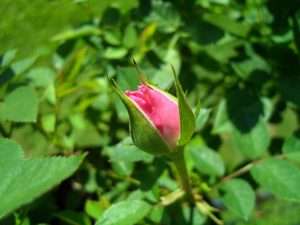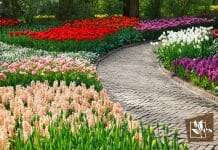 Kordana mini roses belong to the Rosaceae family. Caring for a Kordana rose of the Rosa genus is easy because they’re small and resilient.
Kordana mini roses belong to the Rosaceae family. Caring for a Kordana rose of the Rosa genus is easy because they’re small and resilient.
Read on and find out how to care for your Kordana rose.
JUMP TO TOPIC
Kordana Rose Care
- sun
- humidity
- temperature maintenance
A Kordana rose needs 6 hours of sun each day. Avoid keeping it in scorching heat, or the kordana rose will wilt. Without the sun, the Kordana rose will have stunted growth and dull flowers.
Provide enough humidity, so the soil around the Kordana rose never dries out. Add water steadily and keep checking the soil for dryness. Finally, make sure the plant is never chilled or overheated. Fertilizing and pruning are optional but will help the plant grow and bloom.
Water a Kordana roses bush regularly and feed it 4–6 times a year. Use an all-purpose plant formula diluted to 25 percent strength. In the spring and autumn, use granular rose feed once; water well after.
Indoor Care
You can grow Kordana roses in a greenhouse, where you can use grow lights. A greenhouse also lets you maintain the ideal temperature between 40–60 F.
 Humidity for an Indoors Kordana Rose
Humidity for an Indoors Kordana Rose
A Kordana rose needs a slightly humid living space. Normal households at 40–50 percent humidity will dry out a Kordana rose. If the rose’s space is too dry, you will see the leaves drop. Use a humidifier or put the pot on pebbles in a shallow tray with water.
Ideally, your Kordana rose would have humidity from evaporating soil. If you still see the plant dry out, you should mist your Kordana rose. Mist it in the morning or on a sunny day. The plant should dry before nightfall, or it might catch a fungal disease.
Check the top 2–3 inches of soil in the rose’s pot. If they are dry, the humidity is too low. Avoid at all costs overwatering your Kordana rose because the first symptom will be to wilt, but the next step might be dying.
When and Where To Plant Small Roses?
You should plant Kordana roses in the garden when they show strong growth. Put a Kordana rose in a container and set it outside. Wait for its first bloom before planting it in the garden.
You can use small Kordana roses in the garden as low-edging plants. In any other place in the garden, plant them at the base of larger plants. Larger Kordana roses are more suitable for planting in the middle of the garden. You can separate larger Kordana rose bushes and plant each stem as a regular rose.
Breeders developed all Kordana roses for growing in containers. We recommend planting Kordana roses in indoor, patio, or deck pots as decorations. Planting them in the garden is tricky but doable. If you’re lost, contact your vendor and ask how to plant mini garden roses.
 Pruning
Pruning
You need to have clean scissors or shears and some disinfectant. Use rubbing alcohol (isopropyl) or a 10 percent bleach solution to disinfect the pruning tool. Clean the tool between each plant to avoid infecting them. Make sure to treat each rose part differently and carefully.
Find fading or old blooms on the Kordana rose and cut them off. Work from the top of the bush down and cut at a 45-degree angle. Remove damaged leaves as soon as you notice them. Also, remove any dead, twiggy, or interfering growth.
Remove crossed or weak branches by late winter. Cut above the swellings on the stem where new growth appears. Remove at most 30 percent of the growth and aim for an “open vase” contour. Trimmings decompose slowly, so don’t use them in your compost pile.
 The Right Type of Soil
The Right Type of Soil
Provide your Kordana rose with moist but not wet soil. The soil shouldn’t be soggy. Avoid soil types that dry out too quickly; sandy soils are ideal. High-peat soil will make a Kordana rose dry out within a few hours. Add water-absorbing crystals to your soil.
Vendors sell these as “hydrogel,” with some brand names being:
- Moisture Mizer
- TerraSorb
- Watersave
- Soil Moist
You should use one tablespoon of these crystals for a 6-inch pot. Poke a vertical hole in the soil using a pencil or a twig. Pour the crystals down the hole.
Making a Kordana Rose Container
You can use any container that will hold soil. A bucket or a container 10–12 inches deep will do just fine. Avoid using a clear container since sunshine can burn the root system.
The container you choose should have drainage holes at the bottom. If it doesn’t, drill a few 3/8-inch holes yourself. Put pebbles or gravel in the container until you have a 3/4-inch layer; it will help drain the soil. Put any store-bought bagged soil on top of the gravel.
Growing Mini Garden Roses Outdoors
These small roses grow in USDA zones 6–9. Plant them where they’re protected from chills and winds. Choose a spot with either filtered or some direct sunlight. Remove Kordana miniature roses’ deadheads regularly.
If planting Kordana roses in a large outdoor pot, keep an eye on temperatures. When the temperature drops below 40 F, move the pot to an insulated place, such as a garage, shed, or basement. As long as the air temperature doesn’t drop below -29 F, Kordana roses should survive.
How To Mulch Kordana Miniature Roses
If you leave a Kordana rose in the soil during winter, use 1–2 inches of mulch with one of these:
- shredded bark
- cocoa bean hulls
- compost
Mulch will keep the moisture in the soil during winter. It will also protect the roots from sudden freezing. Add more mulch to cover the crown as temperatures drop, and wrap it with breathable wrap or burlap.
How Big Do Kordana Roses Get?
Kordana rose size varies from 8–36 inches tall and 7–30 inches wide. The American Rose Society says you can expect 15–30 inches in height from a miniature.
Ask your vendor about these Kordana roses breeds:
- tiny
- medium-sized
- large
Tiny Kordana roses, such as Little Pink Marina Kordana, grow up to 7 inches tall.
Medium-sized Kordana roses, such as Honey Kordana, grow up to 24 inches tall.
Large Kordana roses, such as Roxy Kordana, grow up to 36 inches tall.
Diseases
Fungal diseases are the biggest problem for Kordana roses.
These are:
- black spot
- mildew
- rust

The black spot (Diplocarpon rosae) looks like reddish-black stains on the rose’s leaves. The leaves then turn yellow and fall off. Black spot appears during humid weather when the temperature drops at night. Reduce the time leaves are wet to prevent the black spot.
Mildew (Sphaerotheca) is white powder; rust (Phragmidium) is spongy orange growth on leaves. Prevent both by having a steady airflow around the rose. Dry out and clean the plant’s immediate area if you notice either. You don’t need to use any chemicals or cures, just manage the environment.
Final note:
The fastest option is to cut banana peels up and blend them with some water . Water the Kordana roses with this mixture.












